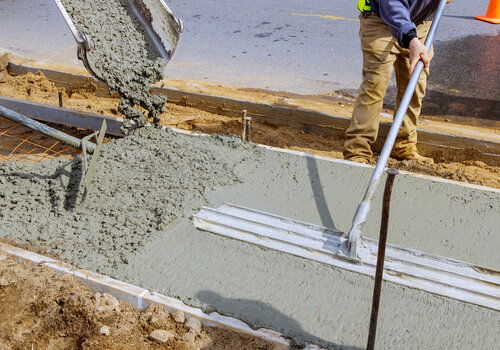Imagine a concrete sidewalk or roadway that quietly repairs its own cracks—no chipping away, no sealing joints, no traffic disruptions. This isn’t sci-fi—it’s smart concrete. Learn more about how this innovative material could help prevent worker accidents, increase sustainability and reduce costs.
WHAT IS SELF-HEALING CONCRETE?
Concrete naturally heals tiny cracks through continued hydration or carbonation—a process known as autogenous healing. But it’s limited to microcracks (10–200 µm) and requires presence of water, making it unreliable in the field.
That’s why researchers are developing controlled, engineered self-healing techniques:
Mineral & crystalline admixtures boost hydration or block pores, improving healing and reducing permeability.
Superabsorbent polymers (SAPs) + fibers help cracks self-seal by swelling and promoting internal hydration; lab testing has shown up to ~85% crack sealing and restoration of mechanical properties.
Microcapsules or vascular systems embedded in the mix release healing agents—like sodium silicate or polymers—upon cracking, sealing the damage from within.
Bio concrete: Certain bacteria (like Bacillus species) embedded in the concrete produce calcium carbonate to seal cracks—and even limit oxygen reaching rebar, reducing corrosion risk.
INNOVATIONS ON THE HORIZON
Michigan State University has unveiled a flexible, self-heating, self-healing concrete. This concrete could be used as a layer over asphalt, generating warmth and repairing damage—a double win for durability and wintertime ice/snow management.
National-scale tracking systems like the CP Tech Center’s Concrete Infrastructure Research Database show ongoing U.S. research into this advanced materials that could change how the industry approaches road repairs, with proactive measures that help prevent cracks.
WHY IT MATTERS THIS SUMMER
Summer provides premium curing conditions and moisture control—prime time for healing technologies to prove their value:
-
Reduce midseason patching. Self healing concrete could slow crack formation and reduce maintenance until cooler months.
-
Extend life and resilience. Perpetual micro repair keeps infrastructure durable longer, reducing total materials and labor over time.
-
Support sustainability goals. Self healing means fewer truck rolls, less material waste and lower embodied carbon—an increasingly crucial factor in project bids and specifications.
TIPS FOR CONTRACTORS
Target high impact areas: Sidewalks, curb ramps, parking aprons and transit stops—places where cracks show up and stay show up.
Do a small-scale test: Use instrumented control vs. healing mix slabs or panels; conduct routine crack width mapping and moisture monitoring over the summer for measurable outcomes.
Talk to suppliers now: Some admixture and specialty cement vendors are starting to stock crystalline—or SAP-modified products. Ask for mix designs, dosage rates and compatibility with standard paving practices.
SUSTAINABILITY & SAFETY WINS
Manual crack repairs require crews to be in traffic. Self-healing concrete could help prevent injuries and deaths with fewer worker needed in dangerous work zones.
Material savings add up as even small reductions in repair volumes cut aggregate and cement demand.
Lower life-cycle costs save both work hours and money. Though healing concrete may carry an upfront premium, the longer-lasting infrastructure can save dollars and resources over decades.
LOOKING AHEAD
Many U.S. DOTs and university labs are launching pilot panels of self-healing concrete, with monitoring throughout summer months. The MSU innovation alone opens the door for smart blends that can nurture their own micro-repair and resist natural stresses like temperature and freeze–thaw cycles.
3 QUESTIONS TO ASK BEFORE SPECIFYING SELF-HEALING CONCRETE
1. What’s the crack environment and moisture exposure?
-
Is this an exterior slab, bridge deck, sidewalk or parking apron?
-
Does it see regular wet-dry cycles or stay mostly dry?
-
Moisture is critical for activating certain healing mechanisms (e.g., SAPs, bacteria).
2. Which healing mechanism matches the job?
-
Crystalline admixtures: Best for reducing permeability and sealing microcracks.
-
Bacteria-based: Suited for wet-dry environments; can seal cracks up to ~1 mm.
-
Microcapsules: Trigger only when cracks occur, releasing sealants.
-
Self-heating blends: Ideal for freeze–thaw zones where warmth aids healing.
3. What’s the life-cycle and inspection plan?
-
How will you measure crack closure over time?
-
Will you core or use NDT (ultrasound, infrared) to verify performance?
-
Can the owner commit to post-installation monitoring for at least two seasons?
Don’t wait to upgrade your paving approach. Put the latest concrete innovations to work on your next project and tap into technology trends in concrete that boost efficiency, quality and sustainability.
Photo credit: SHUTTERSTOCK/UNGVAR












